Résultats de recherche de titre
Articles 1495781 à 1495800 sur 1497201
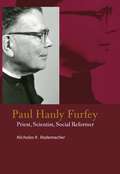
Paul Hanly Furfey: Priest, Scientist, Social Reformer (Catholic Practice in North America)
Par Nicholas K. Rademacher. 2017
Nicholas Rademacher’s book is meticulously researched and clearly written, shedding new light on Monsignor Paul Hanly Furfey’s life by drawing…
on Furfey’s copious published material and substantial archival deposit. Paul Hanly Furfey (1896–1992) is one of U.S. Catholicism’s greatest champions of peace and social justice. He and his colleagues at The Catholic University of America offered a revolutionary view of the university as a center for social transformation, not only in training students to be agents for social change but also in establishing structures which would empower and transform the communities that surrounded the university. In part a response to the Great Depression, their social settlement model drew on the latest social scientific research and technique while at the same time incorporating principles they learned from radical Catholics like Dorothy Day and Catherine de Hueck Doherty. Likewise, through his academic scholarship and popular writings, Furfey offered an alternative vision of the social order and identified concrete steps to achieve that vision. Indeed, Furfey remains a compelling exemplar for anyone who pursues truth, beauty, and justice, especially within the context of higher education and the academy.Leaving behind an important legacy for Catholic sociology, Furfey demonstrated how to balance liberal, radical, and revolutionary social thought and practice to elicit new approaches to social reform.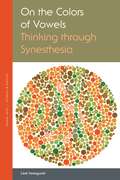
On the Colors of Vowels: Thinking through Synesthesia (Verbal Arts: Studies in Poetics)
Par Liesl Yamaguchi. 2025
Treatments of synesthesia in the arts and humanities generally assume a clear distinction between the neurological condition and the literary…
device. Synesthetes’ descriptions of colors seen in connection with music, for example, are thought to differ fundamentally from common expressions that rely on transpositions across sensory dimensions (“bright vowels”). This has not always been the case. The distinction emerged over the course of the twentieth century, as scientists sought to constitute “synesthesia” as a legitimate object of modern science.On the Colors of Vowels investigates the ambiguity of visual descriptions of vowels across a wide range of disciplines, casting several landmark texts in a wholly new light. The book traces the migration of sound-color correspondence from its ancient host (music) to its modern one (vowels), investigating the vocalic Klangfarben of Hermann von Helmholtz’s monumental Sensations of Tone, the vowel colors reported in early psychology surveys into audition colorée (colored hearing), the mis-matched timbres that form poetry’s condition of possibility in Stéphane Mallarmé’s “Crisis of Verse,” and the vowel-color analogy central to both the universal alphabets of the nineteenth century and the phonological universals of the twentieth. The book’s final chapter turns to an intricately detailed account of vowel-color correspondence by Ferdinand de Saussure, suggesting how the linguist’s sensitivity to vowel coloration may have guided his groundbreaking study of Indo-European vocalism.Bringing out the diverse ways in which visual conceptions of vowels have inflected the arts and sciences of modernity, On the Colors of Vowels makes it possible to see how discourses of the nineteenth and twentieth centuries crafted the enigma we now readily recognize as “synesthesia.”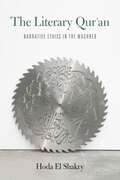
The Literary Qur'an: Narrative Ethics in the Maghreb
Par Hoda El Shakry. 2020
Winner, 2020 Aldo and Jeanne Scaglione Prize for Comparative Literary Studies, Modern Language AssociationThe novel, the literary adage has it,…
reflects a world abandoned by God. Yet the possibilities of novelistic form and literary exegesis exceed the secularizing tendencies of contemporary literary criticism. Showing how the Qurʾan itself invites and enacts critical reading, Hoda El Shakry’s Qurʾanic model of narratology enriches our understanding of literary sensibilities and practices in the Maghreb across Arabophone and Francophone traditions. The Literary Qurʾan mobilizes the Qurʾan’s formal, narrative, and rhetorical qualities, alongside embodied and hermeneutical forms of Qurʾanic pedagogy, to theorize modern Maghrebi literature. Challenging the canonization of secular modes of reading that occlude religious epistemes, practices, and intertexts, it attends to literature as a site where the process of entextualization obscures ethical imperatives. Engaging with the Arab-Islamic tradition of adab—a concept demarcating the genre of belles lettres, as well as social and moral comportment—El Shakry demonstrates how the critical pursuit of knowledge is inseparable from the spiritual cultivation of the self.Foregrounding form and praxis alike, The Literary Qurʾan stages a series of pairings that invite paratactic readings across texts, languages, and literary canons. The book places twentieth-century novels by canonical Francophone writers (Abdelwahab Meddeb, Assia Djebar, Driss Chraïbi) into conversation with lesser-known Arabophone ones (Maḥmūd al-Masʿadī, al-Ṭāhir Waṭṭār, Muḥammad Barrāda). Theorizing the Qurʾan as a literary object, process, and model, this interdisciplinary study blends literary and theological methodologies, conceptual vocabularies, and reading practices.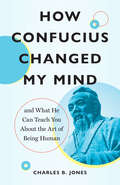
How Confucius Changed My Mind: And What He Can Teach You about the Art of Being Human
Par Charles B. Jones. 2025
A compelling exploration of humanity, morality, religious practice, and leading a good life based on traditional Confucian thought.In this exploration…
of humanity, morality, religious practice, and leading a good life based on traditional Confucian thought, you are invited on a path of transformation. The unexpected depths to be found in Confucianism surprised author Charles Jones when he began teaching East Asian religions to undergraduate students thirty years ago. It raised fascinating questions relevant to life today, like what does it mean to be human? To understand the Confucian answers to these questions, Jones familiarizes us with Confucius, his main successors, and the situations to which their writings responded.But this is not another textbook introduction to Chinese religion and thought. Jones is an engaging, inquisitive scholar and thought provocateur whose ideas address problems all of us face throughout our lives. By engaging with the Confucian ideas explored in this book, like rethinking &“human nature&” and uncovering cultural presuppositions previously unnoticed, you might discover new horizons and possibilities for your life that previously you never could have imagined. And you will discover Confucius in an all-new light as a profound shaper of modern thought as much as Aristotle and Lao-tzu—whose revolutionary ideas have the power to change your mind for the better.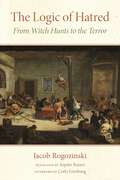
The Logic of Hatred: From Witch Hunts to the Terror
Par Jacob Rogozinski. 2024
This book works to uncover the logic of hatred, to understand how this affect manifests itself historically in persecution and…
terror apparatuses. More than a historical genealogy of persecution, The Logic of Hatred shows what phenomenology can offer to historical understanding. Focusing on the witch-hunts waged in the fifteenth through seventeenth centuries, the first part of the book analyzes the techniques instigators used to designate and annihilate their targets: the search for diabolical stigma, the confession of “truth” extracted by torture, the constitution of an absolute Enemy through the suggestion of conspiracy, of a world turned upside-down, or the figure of Satan.Rogozinski locates one of the origins of the witch-hunt in the anguish that popular uprisings arouse in dominant classes. The second part of the book extends the investigation to related phenomena, such as the extermination of lepers in the Middle Ages and the Reign of Terror during the French Revolution. By studying these historical experiences and marking their differences and similarities, this book shows the passage from exclusion to persecution and how revolts of the oppressed can let themselves be transformed and captured by persecutory politics. The analyses presented thus shed light on conspiracy theory and the terror apparatuses of our time.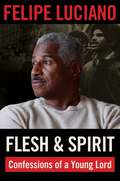
Flesh and Spirit: Confessions of a Young Lord
Par Felipe Luciano. 2024
WINNER, AMERICAN BOOK AWARDChronicles a Black Puerto Rican man’s odyssey and transformation from an incarcerated gang member to the Co-Founder…
of the Young Lords Party.Growing up fatherless and poor, Felipe Luciano didn’t yearn for wealth or dream of becoming a famous actor or athlete. He was tired of being poor and ached to be a man, to reach that point of sagacity, courage, and independence that would signal to the world that he was now a warrior, ready to fight the battle for truth and justice, to slay the dragon of evil, whatever that might be. In Flesh and Spirit, Luciano paints a vivid portrait of his life in New York City as a member of the city’s Latino community as well as his pivotal role in the Young Lords and The Last Poets.Luciano’s memoir begins when as a teenage Brooklyn gang member he is convicted of manslaughter. This pivotal moment changes the trajectory of his life. The American kid raised on Davy Crockett and Superman TV tales emerged from the womb of prison into a harsh, new monochromatic black/white world without the benefit of rose-colored glasses. It was a painful shattering of all his childhood beliefs and the realization that he was a poor Black Puerto Rican in white America clutching onto values that didn’t work. The only flotsam in this churning sea of ’60s social turmoil was college, poetry, revolutionary activity, and sometimes God. After getting an education, Luciano went on to become an acclaimed poet and political activist who advocates for the Latino population of New York City, for the kids growing up in the same circumstances he did.Sparing no one—not the revolutionaries, the Revolution, nor the author himself—Flesh and Spirit is written with honesty and humility to help guide young people of color and other Americans through the labyrinths of ideology, organization, missteps, false paths, and phony societal promises.Featuring archival photographs by Michael Abramson reproduced from Palante: Voices and Photographs of the Young Lords, 1969-1971 © 2011 Haymarket Books.
Class Acts: Derrida on the Public Stage (Perspectives in Continental Philosophy)
Par Michael Naas. 2021
Class Acts examines two often neglected aspects of Jacques Derrida’s work as a philosopher, his public presentations at lectures and…
conferences and his teaching, along with the question of the “speech act” that links them. What, Michael Naas asks, is one doing when one speaks in public in these ways?The book follows Derrida’s itinerary with regard to speech act theory across three public lectures, from 1971 to 1997, all given, for reasons the book seeks to explain, in Montreal. In these lectures, Derrida elaborated his critique of J. L. Austin and his own subsequent redefinition of speech act theory. The book then gives an overview of Derrida’s teaching career and his famous “seminar” presentations, along with his own explicit reflections on pedagogy and educational institutions beginning in the mid-1970s. Naas then shows through a reading of three recently published seminars—on life death, theory and practice, and forgiveness—just how Derrida the teacher interrogated and deployed speech act theory in his seminars. Whether in a conference hall or a classroom, Naas demonstrates, Derrida was always interested in the way spoken or written words might do more than simply communicate some meaning or intent but might give rise to something like an event. Class Acts bears witness to the possibility of such events in Derrida’s work as a pedagogue and a public intellectual.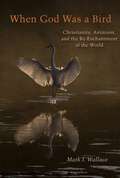
2019 NAUTILUS GOLD WINNERIn a time of rapid climate change and species extinction, what role have the world’s religions played…
in ameliorating—or causing—the crisis we now face? Religion in general, and Christianity in particular, appears to bear a disproportionate burden for creating humankind’s exploitative attitudes toward nature through unearthly theologies that divorce human beings and their spiritual yearnings from their natural origins. In this regard, Christianity has become an otherworldly religion that views the natural world as “fallen,” as empty of signs of God’s presence.And yet, buried deep within the Christian tradition are startling portrayals of God as the beaked and feathered Holy Spirit – the “animal God,” as it were, of historic Christian witness. Through biblical readings, historical theology, continental philosophy, and personal stories of sacred nature, this book recovers the model of God in Christianity as a creaturely, avian being who signals the presence of spirit in everything, human and more-than-human alike. Mark Wallace’s recovery of the bird-God of the Bible signals a deep grounding of faith in the natural world. The moral implications of nature-based Christianity are profound. All life is deserving of humans’ care and protection insofar as the world is envisioned as alive with sacred animals, plants, and landscapes. From the perspective of Christian animism, the Earth is the holy place that God made and that humankind is enjoined to watch over and cherish in like manner. Saving the environment, then, is not a political issue on the left or the right of the ideological spectrum, but, rather, an innermost passion shared by all people of faith and good will in a world damaged by anthropogenic warming, massive species extinction, and the loss of arable land, potable water, and breathable air. To Wallace, this passion is inviolable and flows directly from the heart of Christian teaching that God is a carnal, fleshy reality who is promiscuously incarnated within all things, making the whole world a sacred embodiment of God’s presence, and worthy of our affectionate concern. This beautifully and accessibly written book shows that “Christian animism” is not a strange oxymoron, but Christianity’s natural habitat. Challenging traditional Christianity’s self-definition as an other-worldly religion, Wallace paves the way for a new Earth-loving spirituality grounded in the ancient image of an animal God.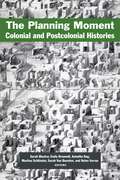
The Planning Moment: Colonial and Postcolonial Histories
Par Sarah Blacker, Emily Brownell, Anindita Nag, Martina Schlünder, Sarah Van Beurden and Helen Verran. 2024
Empires and their aftermaths were massive planning institutions; in the past two hundred years, the natural and social sciences emerged—at…
least in part—as modes of knowledge production for imperial planning. Yet these connections are frequently under-emphasized in the history of science and its corollary fields. The Planning Moment explores the myriad ways plans and planning practices pervade recent global history. The book is built around twenty-seven brief case studies that explore the centrality of planning in colonial and postcolonial environments, relationships, and contexts, through a range of disciplines: the history of science, science and technology studies, colonial and postcolonial studies, urban studies, and the history of knowledge.If colonialism made certain landscapes, populations, and institutions legible while obscuring others, The Planning Moment reveals the frequently disruptive and violent processes of erasure in imperial planning by examining how “common sense” was produced and how the intransigence of planning persists long after decolonization. In recognizing the resistance and subversion that often met colonial plans, the book makes visible a range of strategies and techniques by which planning was modified and reappropriated, and by which decolonial futures might be imagined.Contributors: Itty Abraham, Benjamin Allen, Sarah Blacker, Emily Brownell, Lino Camprubí, John DiMoia, Mona Fawaz, Lilly Irani, Chihyung Jeon, Robert Kett, Monika Kirloskar-Steinbach, Karen McAllister, Laura Mitchell, Gregg Mitman, Aaron Moore (†), Nada Moumtaz, Tahani Nadim, Anindita Nag, Raúl Necochea López, Tamar Novick, Benjamin Peters, Juno Salazar Parreñas, Martina Schlünder, Sarah Van Beurden, Helen Verran, Ana Carolina Vimieiro Gomes, Alexandra Widmer, and Alden Young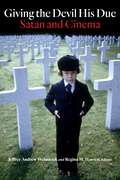
Giving the Devil His Due: Satan and Cinema
Par Jeffrey Andrew Weinstock and Regina M. Hansen. 2021
Finalist, 2021 Bram Stoker Awards (Superior Achievement in Non-Fiction)The first collection of essays to address Satan’s ubiquitous and popular appearances…
in filmLucifer and cinema have been intertwined since the origins of the medium. As humankind’s greatest antagonist and the incarnation of pure evil, the cinematic devil embodies our own culturally specific anxieties and desires, reflecting moviegoers’ collective conceptions of good and evil, right and wrong, sin and salvation. Giving the Devil His Due is the first book of its kind to examine the history and significance of Satan onscreen. This collection explores how the devil is not just one monster among many, nor is he the “prince of darkness” merely because he has repeatedly flickered across cinema screens in darkened rooms since the origins of the medium. Satan is instead a force active in our lives. Films featuring the devil, therefore, are not just flights of fancy but narratives, sometimes reinforcing, sometimes calling into question, a familiar belief system.From the inception of motion pictures in the 1890s and continuing into the twenty-first century, these essays examine what cinematic representations tell us about the art of filmmaking, the desires of the film-going public, what the cultural moments of the films reflect, and the reciprocal influence they exert. Loosely organized chronologically by film, though some chapters address more than one film, this collection studies such classic movies as Faust, Rosemary’s Baby, The Omen, Angel Heart, The Witch, and The Last Temptation of Christ, as well as the appearance of the Devil in Disney animation.Guiding the contributions to this volume is the overarching idea that cinematic representations of Satan reflect not only the hypnotic powers of cinema to explore and depict the fantastic but also shifting social anxieties and desires that concern human morality and our place in the universe.Contributors: Simon Bacon, Katherine A. Fowkes, Regina Hansen, David Hauka, Russ Hunter, Barry C. Knowlton, Eloise R. Knowlton, Murray Leeder, Catherine O’Brien, R. Barton Palmer, Carl H. Sederholm, David Sterritt, J. P. Telotte, Jeffrey Andrew Weinstock
Conflicts: The Poetics and Politics of Palestine-Israel
Par Liron Mor. 2024
Liron Mor’s book queries what conflict means in the context of Palestine–Israel. Conflict has long been seen as singular and…
primary: as an “original sin” that necessitates the state and underwrites politics. This book problematizes this universal notion of conflict, revealing its colonial implications and proposing that conflicts are always politically constructed after the fact and are thus to be understood in their various specific forms. The book explores sites of poetic and political strife in Palestine–Israel by combining a comparative study of Hebrew and Arabic literature with political and literary theory. Mor leverages an archive that ranges from the 1930s to the present, from prose and poetry to film and television, to challenge the conception of the Palestinian–Israeli context as a conflict, delineating the colonial history of this concept and showing its inadequacy to Palestine–Israel. Instead, Mor articulates locally specific modes of theorizing the antagonisms and mediations, colonial technologies, and anticolonial practices that make up the fabric of this site. The book thus offers five figurative conflictual concepts that are derived from the poetics of the works: conflict (judgment/ishtibāk), levaṭim (disorienting dilemmas), ikhtifāʾ (anti/colonial disappearance), ḥoḳ (mediating law), and inqisām (hostile severance). In so doing, Conflicts aims to generate a historically and geographically situated mode of theory-making, which defies the separation between the conceptual and the poetic.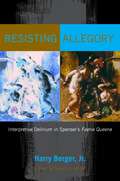
Resisting Allegory: Interpretive Delirium in Spenser's Faerie Queene
Par Harry Berger. 2020
Spenser is a delirious poet. He can’t plough straight. What he builds is shiftier, twistier, than anything dreamed up or…
put down by M. C. Escher. So begins Resisting Allegory, in which the leading Spenser critic of our time sums up a lifelong commitment to the theory and practice of textual interpretation. Spenser’s great poem provides the occasion for a searching and comprehensive interdisciplinary exploration of reading practices¾those the author advocates as well as those he adapts or criticizes in entertaining a wide range of critical arguments with his celebrated combination of intellectual generosity and rigorous questioning.Berger is interested in how details of the poem's language—phrases, images, figures on which we haven’t put enough interpretive pressure—disconcert traditional interpretations and big discourses that the poem has often been thought to serve. Central to this volume is an attention to the deployment of gender in conjunction with the Berger’s notion of narrative complicity.Resisting Allegory offers a model of theoretically sophisticated criticism that never wavers in its close attention to the text. Berger offers a sustained and brilliantly articulated resistance not only to allegory, as the title indicates, but also to prevalent modes of cultural and historical criticism. As in all of Berger’s books, a lucid reflection on questions of method—based on a profound and richly theoretically informed understanding of the workings of language and of the historical situations of the people involved in it—are interwoven with an interpretive practice that serves as an exemplary pedagogical model. Berger attends to historical and political context while deeply respecting the ways in which text can never be reduced to context. This distinctive and original book makes clear the scope and coherence of the critical vision elaborated Berger has elaborated in a lifetime of seminal and still-challenging critical arguments.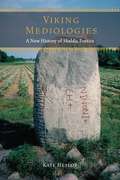
WINNER, ALDO AND JEANNE SCAGLIONE PRIZE FOR STUDIES IN GERMANIC LANGUAGES AND LITERATURESViking Mediologies is a study of pre-modern multimedia…
rooted in the embodied poetic practice of Viking Age skalds. Prior study of the skaldic tradition has focused on authorship—distinctions of poetic style, historical contexts, and attention to the oeuvres of the skalds whose names are preserved in the written tradition. Kate Heslop reconsiders these not as texts but as pieces in a pre-modern media landscape, focusing on poetry’s medial capacity to embody memory, visuality, and sound.Mobile, hybrid, diasporic social formations—bands of raiders and traders, petty kingdoms, colonial expeditions—achieved new prominence in the Viking Age. Skalds offered the leaders of these groups something uniquely valuable. With their complicated poetry, they claimed to be able to capture shared contingent meanings and re-mediate them in named, memorable, reproducible works. The commemorative poetry in kviðuháttr remembers histories of ruin and loss. Skaldic ekphrasis discloses and reproduces the presence of the gods. Dróttkvætt encomium evokes for the leader’s retinue the soundscape of battle.As writing arrived in Scandinavia in the wake of Christianization, the media landscape shifted. In the poetry of the twelfth and thirteenth centuries, skalds adjusted to the demands of a literate audience, while the historical and poetological texts of the Icelandic High Middle Ages opened a dialogue between Latin Christian ideas of mediation and local traditions. In the Second Grammatical Treatise, for example, the literate technology of the grid is used to analyze the complex resonances of dróttkvætt as the output of a syllable-spewing hurdy-gurdy—a poetry machine.Offering both new readings of both canonical works such as Ynglingatal, Ragnarsdrápa, and Háttatal, and examinations of lesser-known texts like Glymdrápa, Líknarbraut, and Sturla Þórðarson’s Hákonarkviða, Viking Mediologies explores the powers and limits of poetic mediation.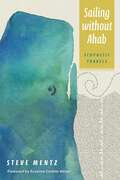
Sailing without Ahab: Ecopoetic Travels
Par Steve Mentz. 2024
Journey through uncharted literary waters and explore Melville’s epic in bold new lightCome sail with I.We’re not taking the same…
trip, though you might recognize the familiar course. This time, the Pequod’s American voyage steers its course across the curvature of the Word Ocean without anyone at the helm. We are leaving one man and his madness on shore. Our ship overflows with glorious plurality—multiracial, visionary, queer, conflicted, polyphonic, playful, violent. But on this voyage something is different. Today we sail headless without any Captain. Instead of binding ourselves to the dismasted tyrant’s rage, the ship’s crew seeks only what we will find: currents teeming with life, a blue-watered alien globe, toothy cetacean smiles from vasty deeps. Treasures await those who sail without.This cycle of one hundred thirty-eight poems—one for each chapter in Moby-Dick, plus the Etymology, Extracts, and Epilogue—launches into oceanic chaos without the stabilizing mad focus of the Nantucket captain. Guided by waywardness and curiosity, these poems seek an alien ecopoetics of marine depths, the refraction of light, the taste of salt on skin. Directionless, these poems reach out to touch oceanic expanse and depth. It’s not an easy voyage, and not a certain one. It lures you forward. It has fixed its barbed hook in I.Sailing without means relinquishing goals, sleeping at the masthead, forgetting obsessions. I welcome you to trace wayward ways through these poems. Read them any way you can—back to front, at random, sideways, following the obscure promptings of your heart. It’s the turning that matters. It’s a blue wonder world that beckons.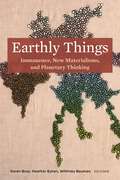
Earthly Things: Immanence, New Materialisms, and Planetary Thinking
Par Karen Bray, Heather Eaton, and Whitney Bauman. 2023
Globalization and climate weirding are two of the leading phenomena that challenge and change the way we need to think…
and act within the planetary community. Modern Western understandings of human beings, animals, and the rest of the natural world and the subsequent technologies built on those understandings have thrown us into an array of social and ecological crises with planetary implications. Earthly Things: Immanence, New Materialisms, and Planetary Thinking, argues that more immanent or planetary ways of thinking and acting have great potential for re-thinking human-technology-animal-Earth relationships and for addressing problems of global climate weirding and other forms of ecological degradation. Older and often-marginalized forms of thought from animisms, shamanisms, and other religious traditions are joined by more recent forms of thinking with immanence such as the universe story, process thought, emergence theory, the new materialisms (NM’s), object-oriented ontologies (OOO’s), affect theory, and queer theory.This book maps out some of the connections and differences between immanent frameworks to provide some eco-intellectual commons for thinking within the planetary community, with a particular emphasis on making connections between more recent theories and older ideas of immanence found in many of the world’s religious traditions. The authors in this volume met and worked together over five years, so the resulting volume reveals sustained and multifaceted perspectives on “thinking and acting with the planet.”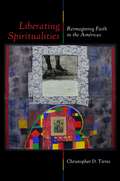
Liberating Spiritualities: Reimagining Faith in the Américas
Par Christopher D. Tirres. 2025
A new perspective on spirituality and social change as seen through the work of six visionary thinkersIn Liberating Spiritualities, Christopher…
D. Tirres offers an in-depth exploration of spirituality as a catalyst for social transformation, showcasing the profound insights of six distinguished twentieth-century liberation thinkers from across the Américas. This thought-provoking work examines the contributions of Marxist philosopher José Carlos Mariátegui, renowned educator and philosopher Paulo Freire, innovative constructive theologian Virgilio Elizondo, influential cultural and feminist theorist Gloria Anzaldúa, activist mujerista theologian and social ethicist Ada María Isasi-Díaz, and groundbreaking ecofeminist theologian Ivone Gebara. Tirres examines the distinct yet interconnected philosophies of these figures, showcasing their unified critique of colonial Christendom and their deep commitment to the marginalized. He adeptly articulates how their diverse religious and philosophical backgrounds come together in a shared vision of spirituality as a fundamental aspect of human life and intelligence. He further illuminates how these thinkers advocate for spirituality as a non-reductive, life-affirming practice, transcending traditional boundaries and offering an integrated approach to faith, culture, and social justice. Their collective insights form a persuasive case for re-envisioning spirituality as a crucial element in the quest for a more just and compassionate world.Liberating Spiritualities is not only a tribute to these six influential figures but also a critical reflection on the relevance of their ideas in today’s global context. Tirres’s transdisciplinary study bridges liberationist and pragmatic insights, offering readers a fresh, highly original interpretation of socially engaged spirituality, making this book an essential resource for those seeking to understand the transformative power of spirituality in the pursuit of social justice and human dignity.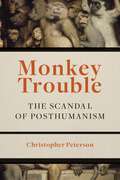
Monkey Trouble: The Scandal of Posthumanism
Par Christopher Peterson. 2018
According to scholars of the nonhuman turn, the scandal of theory lies in its failure to decenter the human. The…
real scandal, however, is that we keep trying.The human has become a conspicuous blind spot for many theorists seeking to extend hospitality to animals, plants, and even insentient things. The displacement of the human is essential and urgent, yet given the humanist presumption that animals lack a number of allegedly unique human capacities, such as language, reason, and awareness of mortality, we ought to remain cautious about laying claim to any power to eradicate anthropocentrism altogether. Such a power risks becoming yet another self-accredited capacity thanks to which the human reaffirms its sovereignty through its supposed erasure.Monkey Trouble argues that the turn toward immanence in contemporary posthumanism promotes a cosmocracy that absolves one from engaging in those discriminatory decisions that condition hospitality as such. Engaging with recent theoretical developments in speculative realism and object-oriented ontology, as well as ape and parrot language studies, the book offers close readings of literary works by J.M. Coetzee, Charles Chesnutt, and Walt Whitman and films by Alfonso Cuarón and Lars von Trier.Anthropocentrism, Peterson argues, cannot be displaced through a logic of reversal that elevates immanence above transcendence, horizontality over verticality. This decentering must cultivate instead a human/nonhuman relationality that affirms the immanent transcendency spawned by our phantasmatic humanness.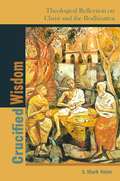
Winner of the Frederick Streng Book Award for Excellence in Buddhist-Christian Studies This work provides the first systematic discussion of…
the Bodhisattva path and its importance for constructive Christian theology. Crucified Wisdom examines specific Buddhist traditions, texts, and practices not as phenomena whose existence requires an apologetic justification but as wells of tested wisdom that invite theological insight. With the increasing participation of Christians in Buddhist practice, many are seeking a deeper understanding of the way the teachings of the two traditions might interface. Christ and the Bodhisattva are often compared superficially in Buddhist–Christian discussion. This text combines a rich exposition of the Bodhisattva path, using Śāntideva’s classic work the Bodicaryāvatāra and subsequent Tibetan commentators, with detailed reflection on its implications for Christian faith and practice.Author S. Mark Heim lays out root tensions constituted by basic Buddhist teachings on the one hand, and Christian teachings on the other, and the ways in which the Bodhisattva or Christ embody and resolve the resulting paradoxes in their respective traditions. An important contribution to the field of comparative theology in general and to the area of Buddhist–Christian studies in particular, Crucified Wisdom proposes that Christian theology can take direct instruction from Mahāyāna Buddhism in two respects: deepening its understanding of our creaturely nature through no-self insights, and revising its vision of divine immanence in dialogue with teachings of emptiness. Heim argues that Christians may affirm the importance of novelty in history, the enduring significance of human persons, and the Trinitarian reality of God, even as they learn to value less familiar, nondual dimensions of Christ’s incarnation, human redemption, and the divine life.Crucified Wisdom focuses on questions of reconciliation and atonement in Christian theology and explores the varying interpretations of the crucifixion of Jesus in Buddhist–Christian discussion. The Bodhisattva path is central for major contemporary Buddhist voices such as the Dalai Lama and Thích Nhât Hanh, who figure prominently as conversation partners in the text. This work will be of particular value for those interested in “dual belonging” in connection to these traditions.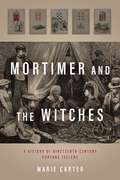
Mortimer and the Witches: A History of Nineteenth-Century Fortune Tellers
Par Marie Carter. 2024
UNTAPPED NEW YORK: THE BEST NYC BOOKS OF ALL TIMEThe neglected histories of 19th-century NYC’s maligned working-class fortune tellers and…
the man who set out to discredit themUnder the pseudonym Q. K. Philander Doesticks, P. B., humor writer Mortimer Thomson went undercover to investigate and report on the fortune tellers of New York City’s tenements and slums. When his articles were published in book form in 1858, they catalyzed a series of arrests that both scandalized and delighted the public. But Mortimer was guarding some secrets of his own, and in many ways, his own life paralleled the lives of the women he both visited and vilified. In Mortimer and the Witches, author Marie Carter examines the lives of these marginalized fortune tellers while also detailing Mortimer Thomson’s peculiar and complicated biography.Living primarily in the poor section of the Lower East Side, nineteenth-century fortune tellers offered their clients answers to all questions in astrology, love, and law matters. They promised to cure ailments. They spoke of loved ones from beyond the grave. Yet Doesticks saw them as the worst of the worst evil-doers. His investigative reporting aimed to stop unsuspecting young women from seeking the corrupt soothsaying advice of these so-called clairvoyants and to expose the absurd and woefully inaccurate predictions of these “witches.”Marie Carter views these stories of working-class, immigrant women with more depth than Doesticks’s mocking articles would allow. In her analysis and discussion, she presents them as three-dimensional figures rather than the caricatures Doesticks made them out to be. What other professions at that time allowed women the kind of autonomy afforded by fortune-telling? Their eager customers, many of whom were newly arrived immigrants trying to navigate life in a new country, weren’t as naive and gullible as Doesticks made them out to be. They were often in need of guidance, seeking out the advice of someone who had life experience to offer or simply enjoying the entertainment and attention.Mortimer and the Witches offers new insight into the neglected histories of working-class fortune tellers and the creative ways that they tried to make a living when options were limited for them.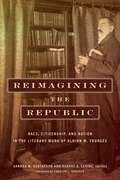
Reimagining the Republic: Race, Citizenship, and Nation in the Literary Work of Albion W. Tourgée (Reconstructing America)
Par Sandra M. Gustafson and Robert S. Levine. 2023
Albion W. Tourgée (1838–1905) was a major force for social, legal, and literary transformation in the second half of the…
nineteenth century. Best known for his Reconstruction novels A Fool’s Errand (1879) and Bricks without Straw (1880), and for his key role in the civil rights case Plessy v. Ferguson (1896), challenging Louisiana’s law segregating railroad cars, Tourgée published more than a dozen novels and a volume of short stories, as well as nonfiction works of history, law, and politics. This volume is the first collection focused on Tourgée’s literary work and intends to establish his reputation as one of the great writers of fiction about the Reconstruction era arguably the greatest for the wide historical and geographical sweep of his novels and his ability to work with multiple points of view. As a white novelist interested in the rights of African Americans, Tourgée was committed to developing not a single Black perspective but multiple Black perspectives, sometimes even in conflict. The challenge was to do justice to those perspectives in the larger context of the story he wanted to tell about a multiracial America. The seventeen essays in this volume are grouped around three large topics: race, citizenship, and nation. The volume also includes a Preface, Introduction, Afterword, Bibliography, and Chronology providing an overview of his career. This collection changes the way that we view Tourgée by highlighting his contributions as a writer and editor and as a supporter of African American writers. Exploring the full spectrum of his literary works and cultural engagements, Reimagining the Republic: Race, Citizenship, and Nation in the Literary Work of Albion Tourgée reveals a new Tourgée for our moment of renewed interest in the literature and politics of Reconstruction.